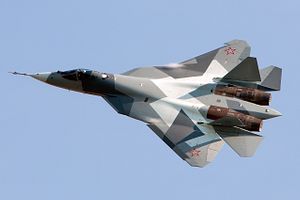The Russian Air Force could possibly start receiving the first serial-produced fifth-generation T-50 (PAK FA) multi-role fighter jet in 2018, according to Russia’s Deputy Defense Minister Yuri Borisov.
Speaking to reporters on February 2, Borisov said that the T-50 PAK FA will “most likely be already in the next state armament program, i.e. 2018-2025,” TASS News Agency reports. Originally, Russia planned to build 250 of the fifth generation aircraft; however, the Russian Air Force announced in 2016 that it will only induct a squadron (18-24 aircraft) for the time being.
The T-50 (PAK FA) — the name will likely change for the production aircraft — is a fifth-generation multi-role, single seat, twin-engine air superiority/deep air support fighter currently under development. It is intended to replace Russia’s aging fleet of MIG-29s and Su-27s.
As I reported elsewhere, eight prototypes of the PAK FA underwent flight trials in 2016. Several hundred test flights have taken place so far. One of the main technical hurdles to overcome, however, remains designing and producing a new engine for the aircraft.
“The fifth-generation engines still do not exist, and the PAK FA still flies on modified engines from the Su-27, Su-30 and other aircraft from that series,” according to a Russian aviation expert.“I think it will have speeds of 1.6 Mach [about 1,200 miles per hour], depending on the location over which the flight takes place. The engine will also improve the PAK FA’s stealth capacity thanks to new composite materials.”
“In addition to the engine, two other things must be done – perfecting the radar systems, and removing the last defects in the concept of the glider, which makes it the most modern plane in the world today,” Pavel Bulat, director of the Mechanics and Energy Systems international Laboratory at the University of Information Technologies, claims in an interview with Russia Beyond the Headlines.
The research and development work for main engines of the T-50 (PAK FA) will be completed by 2020, according to the head of the United Engine Corporation, Sputnik News reports. “This year we plan to begin tests as part of a flight laboratory. R&D completion is planned by 2020.”
Considering that PAK FA prototypes are currently using engines also installed on Sukhoi Su-35S 4++ generation multi-role fighter jets and other Russian fighter jets, it is unclear whether the PAK FA can genuinely be classified as a fifth-generation combat aircraft. Should the Russian Air Force receive the T-50 (PAK FA) prior to 2020, the aircraft will likely need to be upgraded with the new engine in the future.
According to the deputy defense minister, Russia is not in a hurry to field the new aircraft. “We are holding an operational evaluation and have purchased limited batches. We’ll see how they will operate in practice. We are now revealing all drawbacks and making changes to ensure that we purchase practically proven examples when time comes,” he said.
The T-50 (PAK FA) also serves as the prototype for the joint Indo-Russian Sukhoi/HAL Fifth Generation Fighter Aircraft (FGFA) project, or the Perspective Multi-role Fighter (PMF) as it is known in India. Russia and India have also teamed up to develop a light cruise missile (the BrahMos) for the aircraft and other air-based platforms.































